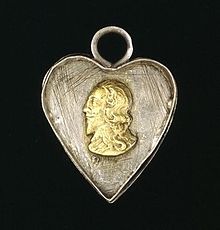
Jewellery consists of decorative items worn for personal adornment, such as brooches, rings, necklaces, earrings, pendants, bracelets, and cufflinks. Jewellery may be attached to the body or the clothes. From a western perspective, the term is restricted to durable ornaments, excluding flowers for example. For many centuries metal such as gold often combined with gemstones, has been the normal material for jewellery, but other materials such as glass, shells and other plant materials may be used.

A pendant is a loose-hanging piece of jewellery, generally attached by a small loop to a necklace, which may be known as a "pendant necklace". A pendant earring is an earring with a piece hanging down. Its name stems from the Latin word pendere and Old French word pendr, both of which translate to "to hang down". In modern French, pendant is the gerund form of pendre and also means "during". The extent to which the design of a pendant can be incorporated into an overall necklace makes it not always accurate to treat them as separate items.

A necklace is an article of jewellery that is worn around the neck. Necklaces may have been one of the earliest types of adornment worn by humans. They often serve ceremonial, religious, magical, or funerary purposes and are also used as symbols of wealth and status, given that they are commonly made of precious metals and stones.

An earring is a piece of jewelry attached to the ear via a piercing in the earlobe or another external part of the ear, or, less often, by some other means. Earrings have been worn by people in different civilizations and historic periods, often with cultural significance.

A button is a fastener that joins two pieces of fabric together by slipping through a loop or by sliding through a buttonhole.

A brooch is a decorative jewellery item designed to be attached to garments, often to fasten them together. It is usually made of metal, often silver or gold or some other material. Brooches are frequently decorated with enamel or with gemstones and may be solely for ornament or serve a practical function as a clothes fastener. The earliest known brooches are from the Bronze Age. As fashions in brooches changed rather quickly, they are important chronological indicators. In archaeology, ancient European brooches are usually referred to by the Latin term fibula.
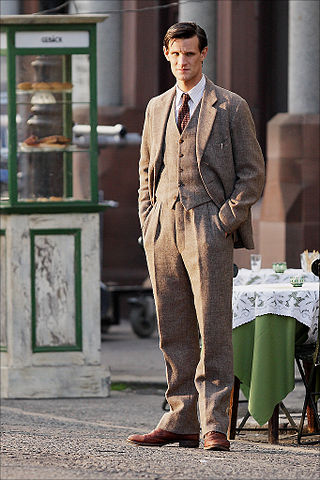
A suit, lounge suit, or business suit is a set of clothes comprising a suit jacket and trousers of identical textiles generally worn with a collared dress shirt, necktie, and dress shoes. A skirt suit is similar, but with a matching skirt instead of trousers. It is currently considered semi-formal wear or business wear in contemporary Western dress codes, however when the suit was originally developed it was considered an informal or more casual option compared to the prevailing clothing standards of aristocrats and businessmen. The lounge suit originated in 19th-century Britain as sportswear and British country clothing, which is why it was seen as more casual than citywear at that time, with the roots of the suit coming from early modern Western Europe formal court or military clothes. After replacing the black frock coat in the early 20th century as regular daywear, a sober one-coloured suit became known as a lounge suit.

A keychain is a small ring or chain of metal to which several keys can be attached. The length of a keychain allows an item to be used more easily than if connected directly to a keyring. Some keychains allow one or both ends to rotate, keeping the keychain from becoming twisted, while the item is being used.

Cufflinks are items of jewelry that are used to secure the cuffs of dress shirts. Cufflinks can be manufactured from a variety of different materials, such as glass, stone, leather, metal, precious metal or combinations of these. Securing of the cufflinks is usually achieved via toggles or reverses based on the design of the front section, which can be folded into position. There are also variants with chains or a rigid, bent rear section. The front sections of the cufflinks can be decorated with gemstones, inlays, inset material or enamel and designed in two or three-dimensional forms.

Fashion in the period 1550–1600 in European clothing was characterized by increased opulence. Contrasting fabrics, slashes, embroidery, applied trims, and other forms of surface ornamentation remained prominent. The wide silhouette, conical for women with breadth at the hips and broadly square for men with width at the shoulders had reached its peak in the 1530s, and by mid-century a tall, narrow line with a V-lined waist was back in fashion. Sleeves and women's skirts then began to widen again, with emphasis at the shoulder that would continue into the next century. The characteristic garment of the period was the ruff, which began as a modest ruffle attached to the neckband of a shirt or smock and grew into a separate garment of fine linen, trimmed with lace, cutwork or embroidery, and shaped into crisp, precise folds with starch and heated irons.

A lock of hair is a piece or pieces of human hair that are usually bunched or tied together in some way. A lock of hair can be on a person's head, or have been cut from the head. When attached to the head, a lock of hair generally refers to a tress, curl, or ringlet of hair. When cut from the head, a lock of hair may be kept for its symbolic value.

Hairwork, or jewelry or artwork made of human hair, has appeared throughout the history of craft work, particularly to be used for private worship or mourning. From the Middle Ages through the early twentieth century, memorial hair jewelry remained common. Hair, considered to be a remnant off the person it was cut from, also has often played a part in myths and legends; in a Swedish book of proverbs, one can read that “rings and bracelets of hair increase love”. One example can be found in Denmark, at Rosensborg’s palace, which is a bracelet of precious metal with a simple braided lock of hair - a gift from King Christian IV (1577-1648) to his queen. Another example would be the rings commemorating the execution of King Charles I of England (1600-1649), which circulated among his faithful supporters. Other famous people who owned hair jewelry include Napoleon, Admiral Nelson, Queen Victoria and her large family, Christina Nilsson and Jenny Lind.
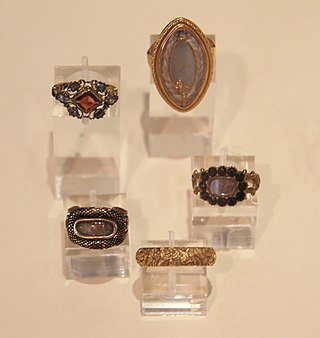
A mourning ring is a finger ring worn in memory of someone who has died. It often bears the name and date of death of the person, and possibly an image of them, or a motto. They were usually paid for by the person commemorated, or their heirs, and often specified, along with the list of intended recipients, in wills. Stones mounted on the rings were usually black, and where it could be afforded jet was the preferred option. Otherwise cheaper black materials such as black enamel or vulcanite were used. White enamel was used on occasion particularly where the deceased was a child. It also saw some use when the person being mourned had not married. In some cases a lock of hair of the deceased person would be incorporated into the ring. The use of hair in mourning rings was not as widespread as it might have been due to concerns that the hair of the deceased would be substituted with other hair.
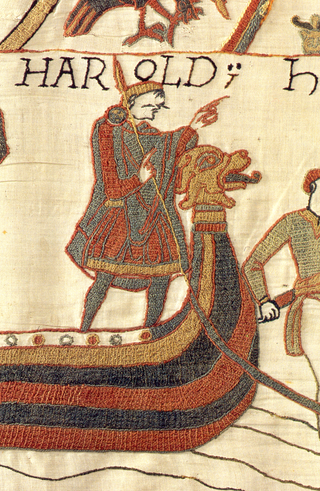
Anglo-Saxon dress refers to the clothing and accessories worn by the Anglo-Saxons from the middle of the second century to the eleventh century. Archaeological finds in Anglo-Saxon cemeteries have provided the best source of information on Anglo-Saxon costume. It is possible to reconstruct Anglo-Saxon dress using archaeological evidence combined with Anglo-Saxon and European art, writing and literature of the period. Archaeological finds have both supported and contradicted the characteristic Anglo-Saxon costume as illustrated and described by these contemporary sources.
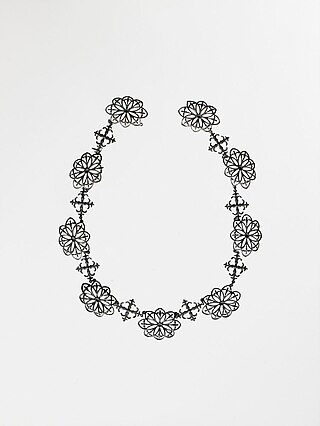
Berlin iron jewellery refers to articles of cast-iron jewellery that were made during the early 19th century in Germany.

A lead, lead line, lead rope (US) or head collar rope (UK), is used to lead an animal such as a horse. Usually, it is attached to a halter. The lead may be integral to the halter or, more often, separate. When separate, it is attached to the halter with a heavy clip or snap so that it can be added or removed as needed. A related term, lead shank or lead chain refers to a lead line with a chain attached that is used in a variety of ways to safely control possibly difficult or dangerous horses if they will not respond to a regular lead.

Eye miniatures or Lovers' eyes were Georgian miniatures, normally watercolour on ivory, depicting the eye or eyes of a spouse, loved one or child. These were usually commissioned for sentimental reasons and were often worn as bracelets, brooches, pendants or rings with richly decorated frames, serving the same emotional need as lockets hiding portraits or locks of hair. This fad started in the late 1700s and miniaturists such as Richard Cosway and George Engleheart were responsible for some of the first pieces.

Breast milk jewelry or Breast milk jewellery is jewellery made from pumped or expressed mother's breast milk as a keepsake often worn by the mother. Breast milk keepsakes come in various jewelry types such as rings, lockets, pendants and popular European style beads. Some pendants may be bezel set, locket set, made from only resin, or filled. Filled styles use a preserved breast milk and resin mix to fill holes or openings in jewelry pieces, usually Sterling Silver. Generally, the filled shapes are trees, leaves, or hearts representing love and life.
Victorian jewellery originated in England. Victorian jewellery was produced during the reign of Queen Victoria, whose reign lasted from 1837 to 1901. Queen Victoria was an influential figure who established the different trends in Victorian jewellery. The amount of jewellery acquired throughout the Victorian era established a person’s identity and status. Within the Victorian period, jewellery consisted of a diverse variety of styles and fashions. These periods can be categorised into three distinct timeframes: The Romantic period, the Grand period and the Aesthetic period.

Jewels! The Glitter of the Russian Court was the second jubileum exhibition in Amsterdam by the H'ART Museum, focussed on the personal taste for luxury by Russian nobility. The show, which was planned to run from 14 September 2019 to 15 March 2020, suffered from the pandemic and was extended twice, ending finally 16 October 2020.
